The Numbing Cream Market is estimated to be valued at USD 3.8 billion in 2025 and is projected to reach USD 6.8 billion by 2035, registering a compound annual growth rate (CAGR) of 6.0% over the forecast period. Between 2025 and 2030, the market is expected to rise from USD 3.8 billion to USD 5.1 billion, driven by the increasing use of numbing creams in medical, cosmetic, and personal care procedures.
Year-on-year analysis shows steady growth, with values reaching USD 4.0 billion in 2026 and USD 4.3 billion in 2027, supported by rising demand for painless procedures and advancements in topical anesthetics. By 2028, the market is forecasted to hit USD 4.5 billion, advancing to USD 4.8 billion in 2029 and USD 5.1 billion by 2030.
Growth is expected to be further fueled by the expansion of the aesthetic surgery market, along with increased awareness of numbing creams in dental and minor dermatological treatments. These dynamics position the numbing cream market as a crucial component in enhancing patient comfort during medical and cosmetic procedures, driving innovations in formulation and application technology.
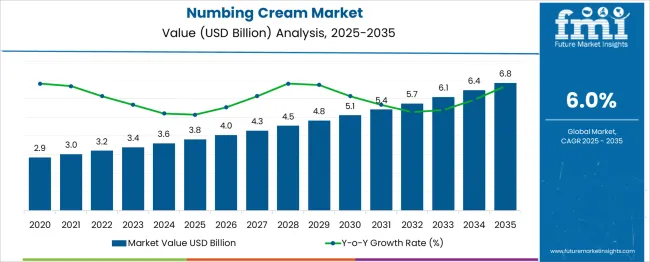
| Metric | Value |
|---|---|
| Numbing Cream Market Estimated Value in (2025 E) | USD 3.8 billion |
| Numbing Cream Market Forecast Value in (2035 F) | USD 6.8 billion |
| Forecast CAGR (2025 to 2035) | 6.0% |
The Numbing Cream market is experiencing robust growth supported by rising demand for minimally invasive cosmetic and medical procedures that require effective pain management. The current market scenario is marked by heightened consumer awareness of aesthetic treatments and increased willingness to invest in personal care.
According to healthcare news, investor briefings, and pharmaceutical company announcements, advancements in formulation technologies and the introduction of skin-friendly ingredients have further expanded the market potential. Regulatory approvals for over-the-counter products and growing adoption in dermatology and tattoo applications are strengthening the market’s foundation.
Future opportunities are expected to emerge from broader application areas, such as pediatric care and chronic pain management, as reported in corporate presentations and medical journals. Sustainability considerations and improved access to affordable products in emerging economies are also paving the way for sustained market growth in the coming years.
The numbing cream market is segmented by product type, application, price range, end use, distribution channel, and geographic regions. By product type, the numbing cream market is divided into Topical anesthetic creams, Topical analgesics, and Others. In terms of application, the numbing cream market is classified into Cosmetic procedures, Medical purposes, and Pain management. Based on price range, the numbing cream market is segmented into mid, Low, and High.
The end use of the numbing cream market is segmented into Hospitals and clinics, Home use, Beauty parlours, and Others (tattoo parlours, etc.). The distribution channel of the numbing cream market is segmented into Pharmacies and drug stores, Online retail, and Medical supply distributors. Regionally, the numbing cream industry is classified into North America, Latin America, Western Europe, Eastern Europe, Balkan & Baltic Countries, Russia & Belarus, Central Asia, East Asia, South Asia & Pacific, and the Middle East & Africa.
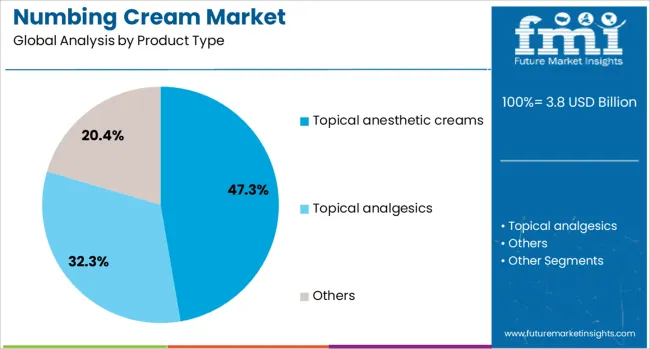
The topical anesthetic creams product type is expected to hold 47.3% of the Numbing Cream market revenue share in 2025, maintaining its position as the leading product type segment. This prominence is being attributed to their ease of application, fast onset of action, and suitability for a wide range of procedures, as noted in pharmaceutical product updates and dermatology publications.
Healthcare professionals have preferred topical anesthetic creams because of their ability to provide localized pain relief without the risks associated with systemic administration. Investor communications have highlighted that improved formulations with skin-nourishing properties have enhanced user experience and safety, supporting wider adoption.
Additionally, these creams are being favored due to their affordability and accessibility in both clinical and at-home settings. The flexibility to use them in diverse environments and their compatibility with cosmetic and medical procedures have further reinforced their dominance in the market.
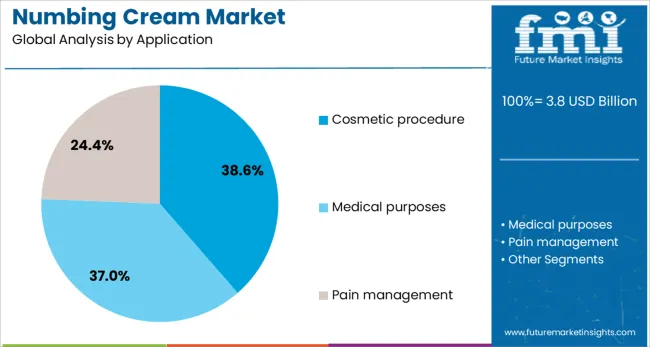
The cosmetic procedure application segment is projected to account for 38.6% of the Numbing Cream market revenue share in 2025, establishing it as the largest application segment. Growth in this segment has been driven by increased consumer interest in aesthetic enhancements and higher frequency of procedures such as laser treatments, microblading, and chemical peels, as outlined in clinic press releases and beauty industry journals.
The growing number of dermatology clinics and medspas offering advanced treatments has also increased the demand for numbing solutions to enhance patient comfort. Product announcements have shown that improved efficacy and safer formulations have made these creams more acceptable among practitioners and clients alike.
The segment’s strength has been further bolstered by the rising adoption of social media-driven beauty trends and awareness campaigns that encourage minimally invasive procedures. These factors have collectively positioned the cosmetic procedure segment as a major contributor to the market’s growth.
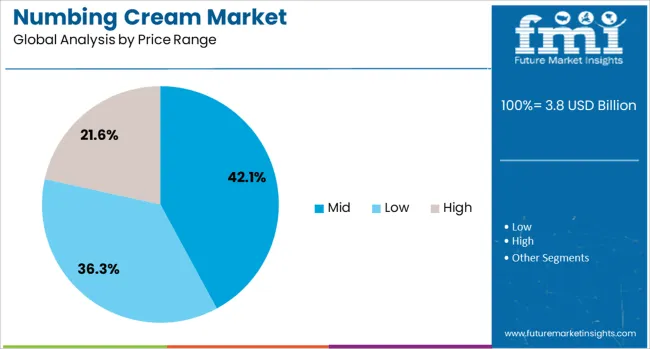
The mid price range segment is forecasted to contribute 42.1% of the Numbing Cream market revenue share in 2025, retaining its leadership within the market. This dominance is being reinforced by its ability to balance affordability with quality, catering to both mass and premium consumer needs, as observed in pharmacy retail announcements and healthcare company reports.
Consumers have been gravitating toward this range due to its perceived value, offering reliable efficacy without the premium cost associated with high-end products. Investor updates have highlighted that brands in the mid price tier have successfully expanded their reach through both offline and online channels, enhancing accessibility in diverse markets.
The segment has also been supported by consistent innovation in packaging and formulation while maintaining competitive pricing strategies. These factors have ensured the mid price range remains a preferred choice for both healthcare providers and end-users, driving its continued growth in the market.
The numbing cream market is driven by increasing demand for effective, non-invasive pain relief, particularly in medical and cosmetic applications. Opportunities are growing in the cosmetic sector, while emerging trends in natural formulations are reshaping the market. Challenges like regulatory hurdles and product safety concerns may slow growth. By 2025, addressing these challenges will be essential for continued market expansion.
The numbing cream market is expanding due to the growing demand for effective pain management solutions. Non-invasive options for temporary pain relief are highly sought after in medical, cosmetic, and dermatological procedures. Numbing creams offer a convenient alternative to injections or oral medications, particularly in procedures like tattooing, waxing, and minor surgeries. As consumer awareness of these products rises, the market is expected to grow steadily, driven by both individual users and professionals seeking safe, fast-acting solutions.
Opportunities in the numbing cream market are increasing, particularly in cosmetic and dermatological applications. The demand for numbing creams in procedures like laser treatments, chemical peels, and microdermabrasion is on the rise. These products provide pain relief during aesthetic treatments, which continue to grow in popularity. By 2025, the cosmetic sector is likely to account for a substantial portion of the market share, with the demand for non-invasive beauty treatments continuing to fuel market expansion.
Emerging trends in the numbing cream market show a shift toward natural and topical formulations. With growing consumer preference for plant-based and herbal ingredients, many numbing creams are incorporating natural compounds, such as aloe vera and lidocaine alternatives. These formulations are gaining popularity due to their skin-friendly properties and reduced side effects. By 2025, natural numbing creams are expected to dominate, particularly in sensitive skin treatments and among consumers seeking mild yet effective pain relief.
The numbing cream market faces challenges related to regulatory hurdles and product safety concerns. Regulatory agencies, such as the FDA, impose strict guidelines on the formulation and marketing of topical anesthetics, which can slow down the approval process for new products. Additionally, potential side effects or allergic reactions associated with numbing creams could hinder market acceptance. Ensuring safety and compliance with regulatory standards will be crucial for manufacturers to maintain growth and consumer trust by 2025.
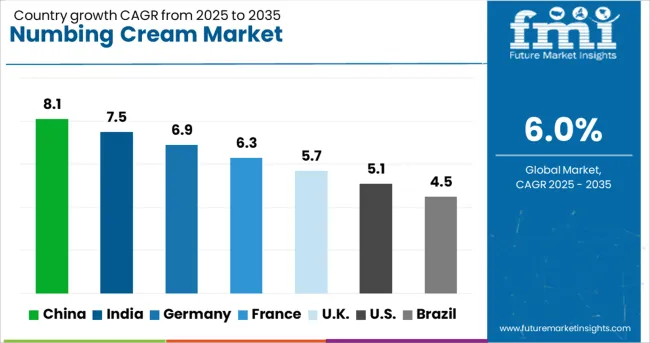
| Country | CAGR |
|---|---|
| China | 8.1% |
| India | 7.5% |
| Germany | 6.9% |
| France | 6.3% |
| UK | 5.7% |
| USA | 5.1% |
| Brazil | 4.5% |
The global numbing cream market is projected to grow at a 6% CAGR from 2025 to 2035. China leads with a growth rate of 8.1%, followed by India at 7.5%, and Germany at 6.9%. The United Kingdom records a growth rate of 5.7%, while the United States shows the slowest growth at 5.1%. These differences in growth rates are influenced by regional consumer demand for pain relief solutions, increasing awareness of numbing cream applications, and rising disposable incomes. Emerging markets like China and India are witnessing higher growth due to increasing healthcare needs, a rising middle class, and greater awareness of personal care products, while mature markets like the USA and the UK experience steadier growth driven by established demand and advancements in numbing cream formulations. This report includes insights on 40+ countries; the top markets are shown here for reference.
The numbing cream market in China is growing at an impressive CAGR of 8.1%. As China’s healthcare sector continues to expand and consumer awareness of pain management products rises, the demand for numbing creams is increasing. The growing trend of non-invasive cosmetic procedures, such as laser treatments, dermatological procedures, and tattooing, is driving the adoption of numbing creams. Additionally, the country’s rising disposable income, expanding middle class, and increasing consumer focus on personal care and well-being further contribute to market growth. Government regulations and rising healthcare investments are also supporting the demand for safe and effective numbing cream products.
The numbing cream market in India is projected to grow at a CAGR of 7.5%. The growing number of cosmetic procedures, including skin treatments and tattooing, alongside the increasing prevalence of minor surgeries, is driving demand for numbing creams. With rising disposable incomes and an increasing focus on personal care, Indian consumers are increasingly turning to numbing creams for pain relief. Additionally, the country’s growing healthcare and beauty sectors, along with improved access to such products through retail and e-commerce channels, are expected to further accelerate market growth.
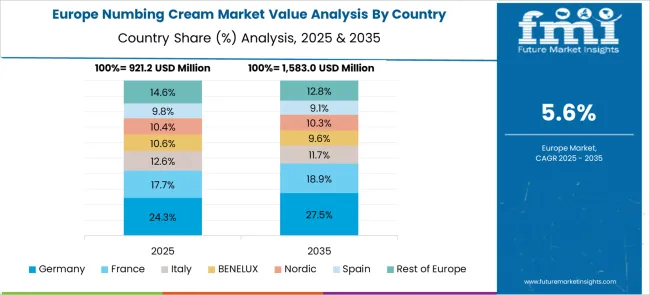
The numbing cream market in Germany is projected to grow at a CAGR of 6.9%. Germany’s well-established healthcare and cosmetic industries are key drivers behind the demand for numbing creams. The rising adoption of non-invasive treatments and increasing awareness of pain relief options in cosmetic and medical procedures is fueling the market. Additionally, Germany’s strong regulations and focus on high-quality, safe products are contributing to the growth of numbing cream sales. As the demand for aesthetic treatments rises, the need for numbing creams in dermatology, laser therapy, and tattooing applications is expected to increase steadily.
The numbing cream market in the United Kingdom is projected to grow at a CAGR of 5.7%. In the UK, the demand for numbing creams is increasing due to rising cosmetic procedures, including laser treatments and aesthetic surgeries. Consumer awareness of pain management in these procedures is growing, driving demand for numbing creams. Additionally, the rise in tattooing, minor surgeries, and skincare treatments is boosting market growth. While the market is more mature, steady demand for numbing creams in both medical and cosmetic applications, along with a growing focus on wellness and self-care, supports continued growth.
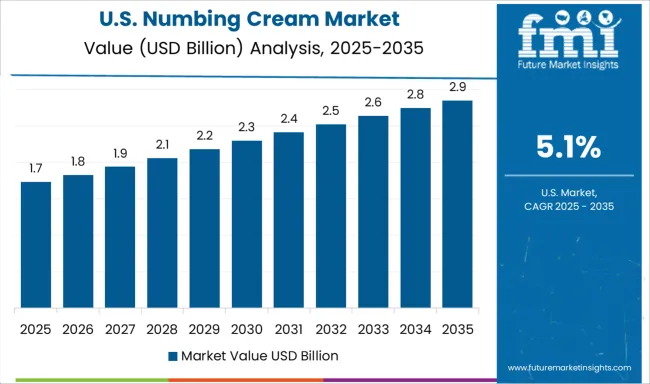
The numbing cream market in the United States is expected to grow at a CAGR of 5.1%. Although the USA market is mature, the ongoing demand for numbing creams in various applications, including dermatological procedures, tattooing, and minor surgeries, ensures steady growth. With a large consumer base seeking pain relief in both medical and cosmetic procedures, the market remains significant. Additionally, increasing awareness of non-invasive treatments, rising interest in beauty and wellness, and the adoption of online retail platforms contribute to the continued growth of the numbing cream market in the USA
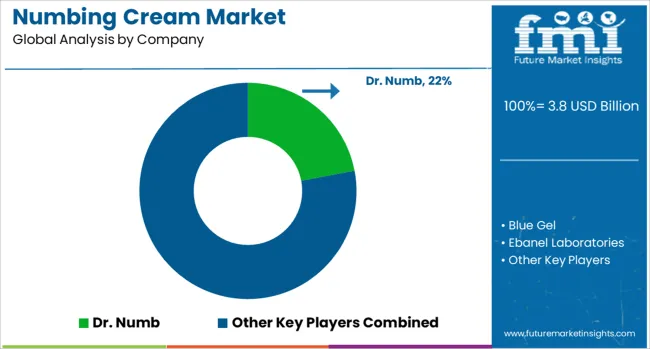
The numbing cream market is dominated by Dr. Numb, which leads with its widely recognized topical anesthetic formulations that provide fast-acting pain relief for a variety of cosmetic, medical, and dermatological procedures. Dr. Numb’s dominance is reinforced by its strong brand presence, extensive distribution channels, and commitment to delivering effective, safe, and easy-to-use numbing creams.
Key players such as Ebanel Laboratories, Blue Gel, and Hush Anesthetic maintain significant market shares by offering a range of high-quality, lidocaine-based creams designed to provide pain relief for procedures such as tattooing, waxing, and laser treatments. These companies focus on product safety, efficacy, and compliance with health regulations to meet the growing demand for at-home and professional numbing solutions.
Emerging players like Lidocaine Plus, LMX4, Numbify, and Numb Master are expanding their market presence by offering more specialized numbing creams, including formulations for specific skin types or sensitive areas. Their strategies include improving cream absorption, extending numbing duration, and targeting niche applications like post-surgery recovery or dental procedures.
Market growth is driven by increasing demand for cosmetic procedures, rising consumer awareness of pain management options, and the growing trend of DIY beauty treatments. Innovations in formulation, such as enhanced skin penetration and natural ingredient-based numbing creams, are expected to further shape competitive dynamics and drive growth in the global numbing cream market.
| Item | Value |
|---|---|
| Quantitative Units | USD 3.8 Billion |
| Product Type | Topical anesthetic creams, Topical analgesics, and Others |
| Application | Cosmetic procedure, Medical purposes, and Pain management |
| Price Range | Mid, Low, and High |
| End Use | Hospitals and clinics, Home use, Beauty parlours, and Others (tattoo parlours, etc.) |
| Distribution Channel | Pharmacies and drug stores, Online retail, and Medical supply distributors |
| Regions Covered | North America, Europe, Asia-Pacific, Latin America, Middle East & Africa |
| Country Covered | United States, Canada, Germany, France, United Kingdom, China, Japan, India, Brazil, South Africa |
| Key Companies Profiled | Dr. Numb, Blue Gel, Ebanel Laboratories, Hush Anesthetic, Lidocaine Plus, LMX4, Numb 520, Numb Master, Numb Max, Numbify, Numb-ify, NumbSkin, Uber Numb, UltraNumb, and Zensa |
| Additional Attributes | Dollar sales by cream type and application, demand dynamics across healthcare, beauty, and cosmetic sectors, regional trends in numbing cream adoption, innovation in faster-acting and long-lasting formulations, impact of regulatory standards on safety and efficacy, and emerging use cases in dermatological treatments and cosmetic procedures. |
The global numbing cream market is estimated to be valued at USD 3.8 billion in 2025.
The market size for the numbing cream market is projected to reach USD 6.8 billion by 2035.
The numbing cream market is expected to grow at a 6.0% CAGR between 2025 and 2035.
The key product types in numbing cream market are topical anesthetic creams, topical analgesics and others.
In terms of application, cosmetic procedure segment to command 38.6% share in the numbing cream market in 2025.






Full Research Suite comprises of:
Market outlook & trends analysis
Interviews & case studies
Strategic recommendations
Vendor profiles & capabilities analysis
5-year forecasts
8 regions and 60+ country-level data splits
Market segment data splits
12 months of continuous data updates
DELIVERED AS:
PDF EXCEL ONLINE
Cream of Tartar Market Size and Share Forecast Outlook 2025 to 2035
Cream Separator Market Size and Share Forecast Outlook 2025 to 2035
Cream Cheese Market Analysis – Size, Share, and Forecast 2025 to 2035
BB Cream Market Analysis by Skin Type, SPF Type, End Uses, Sales Channel and Region through 2025 to 2035
Ice Cream Coating Market Size and Share Forecast Outlook 2025 to 2035
Ice-cream Premix and Stabilizers Market Size and Share Forecast Outlook 2025 to 2035
Ice Cream Equipment Market Size and Share Forecast Outlook 2025 to 2035
Analysis and Growth Projections for Ice Cream and Frozen Dessert Market from 2025 to 2035
Ice Cream Packaging Market - Outlook 2025 to 2035
Ice Cream Processing Equipment Market Growth - Trends, Demand & Innovations 2025 to 2035
Ice Cream Service Supplies Market - Premium Serving Essentials 2025 to 2035
Ice Cream Parlor Market Analysis by Type, Product Type, and Region Through 2035
Breaking Down Market Share in the Ice Cream Parlor Industry
Ice Cream Container Market Size & Trends Forecast 2024-2034
Dry Cream Substitute Market
Ice-cream Maker Market
Precis of Key Trends Shaping Sour Cream Powder Business Landscape.
DMAE Cream Market Report – Growth & Industry Trends 2024-2034
A2 Ice Cream Market Size and Share Forecast Outlook 2025 to 2035
Coffee Creamer Market Analysis by Form, Nature, Category, Application and Sales Channel Through 2025 to 2035

Thank you!
You will receive an email from our Business Development Manager. Please be sure to check your SPAM/JUNK folder too.
Chat With
MaRIA